Triple Time Interval Hybridization Strategy for Rapidly Calculating Regional Target–Visible Time Window of Earth Observation Payloads on Space Station
Abstract
1. Introduction
2. Preliminary Work
2.1. Theoretical Foundation
2.2. Mathematical Analysis
3. Method
3.1. Basic Idea
- (1)
- In case (a), regions C and D are separate, with region C not containing point S;
- (2)
- In case (b), regions C and D intersect, with region C not containing point S;
- (3)
- In case (c), regions C and D intersect, with region C containing point S.
| Algorithm 1: Compute Visible Time Window | |
| Input: TLE, the orbit data. α, the payload parameters. (Loni, Lati), the observation target information. | |
| Output: VTW, the visible time window. | |
| 1 | Initialize control parameters and data structures. |
| 2 | Perform time and orbit segmentation. |
| 3 | Expand the boundaries based on the orbit information. |
| 4 | Orbit Position Calculation: |
| 5 | while The circleall have not been all traversed do |
| 6 | if the satellite position reaches the boundary region then |
| 7 | Record the corresponding orbit circle-filtered and |
| start/end time Δt2. | |
| 8 | else |
| 9 | continue to the next time. |
| 10 | end |
| 11 | end |
| 12 | Discretize the boundary region |
| 13 | Angle Calculation: |
| 14 | while The circle-filtered have not been all traversed do |
| 15 | if the angle satisfies the requirements then |
| 16 | Record the corresponding orbit circle-coarse and |
| start/end time Δt3. | |
| 17 | else |
| 18 | continue to the next time. |
| 19 | end |
| 20 | end |
| 21 | Binary Calculation: |
| 22 | while The circle-coarse have not been all traversed do |
| 23 | if The precision criteria are met then |
| 24 | Record the final time. |
| 25 | else |
| 26 | repeat the binary search. |
| 27 | end |
| 28 | end |
3.2. Algorithm Steps
3.2.1. Orbit Filtering
3.2.2. Coarse Calculation
3.2.3. Precise Calculation
4. Results and Discussion
4.1. Evaluation of the Algorithm Performance
4.2. Discussion
5. Conclusions
Author Contributions
Funding
Institutional Review Board Statement
Informed Consent Statement
Data Availability Statement
Conflicts of Interest
References
- Gu, Y. The China Space Station: A new opportunity for space science. Natl. Sci. Rev. 2021, 9, nwab219. [Google Scholar] [CrossRef]
- Crisp, N.; Roberts, P.; Livadiotti, S.; Abrao Oiko, V.T.; Edmondson, S.; Haigh, S.; Huyton, C.; Sinpetru, L.; Smith, K.; Worrall, S.; et al. The benefits of very low earth orbit for earth observation missions. Prog. Aeronaut. Sci. 2020, 117, 100619. [Google Scholar] [CrossRef]
- Chatterjee, A.; Tharmarasa, R. Reward factor-based multiple agile satellites scheduling with energy and memory constraints. IEEE Trans. Aerosp. Electron. Syst. 2022, 58, 3090–3103. [Google Scholar] [CrossRef]
- Chang, Z.; Chen, Y.; Yang, W.; Zhou, Z. Mission planning problem for optical video satellite imaging with variable image duration: A greedy algorithm based on heuristic knowledge. Adv. Space Res. 2020, 66, 2597–2609. [Google Scholar] [CrossRef]
- Chien, S.; Johnston, M.; Frank, J.; Giuliano, M.; Kavelaars, A.; Lenzen, C.; Policella, N. A generalized timeline representation, services, and interface for automating space mission operations. In Proceedings of the 12th International Conference on Space Operations, Stockholm, Sweden, 11–15 June 2012. [Google Scholar]
- Wang, J.J.; Zhu, X.M.; Qiu, D.S.; Yang, L.T. Dynamic scheduling for emergency tasks on distributed imaging satellites with task merging. IEEE T. Parall. Distr. 2013, 25, 2275–2285. [Google Scholar] [CrossRef]
- Lee, K.; Kim, D.J.; Chung, D.W.; Lee, S. Optimal Mission Planning for Multiple Agile Satellites Using Modified Dynamic Programming. J. Aerosp. Inform. Syst. 2023, 21, 279–289. [Google Scholar] [CrossRef]
- Lawton, J.A. Numerical method for rapidly determining satellite-satellite and satellite-ground station in-view periods. J. Guid. Control Dynam. 1987, 10, 32–36. [Google Scholar] [CrossRef]
- Escobal, P.R. Rise and set time of a satellite about an oblate planet. AIAA J. 1963, 1, 2306–2310. [Google Scholar] [CrossRef]
- Alfano, S.; David, N.; Moore, J.L. Rapid determination of satellite visibility periods. J. Astronaut. Sci. 1992, 40, 281–296. [Google Scholar]
- Nugnes, M.; Colombo, C.; Tipaldi, M. Coverage area determination for conical fields of view considering an oblate earth. J. Guid. Control. Dynam. 2019, 42, 2233–2245. [Google Scholar] [CrossRef]
- Katona, Z.; Donner, A. On mean visibility time of non-repeating satellite orbits. In Proceedings of the IEEE International Workshop on Satellite and Space Communications, Toulouse, France, 1–3 October 2008. [Google Scholar]
- Ali, I.; Al-Dhahir, N.; Hershey, J.E. Predicting the visibility of LEO satellites. IEEE Trans. Aerosp. Electron. Syst. 1999, 35, 1183–1190. [Google Scholar] [CrossRef]
- Sengupta, P.; Vadali, S.R.; Alfriend, K.T. Satellite orbit design and maintenance for terrestrial coverage. J. Spacecr. Rocket. 2010, 47, 177–187. [Google Scholar] [CrossRef]
- Sun, X.C.; Cui, H.Z.; Han, C.; Geshi, T. APCHI technique for rapidly and accurately predicting multi-restriction satellite visibility. In Proceedings of the 22nd AAS/AIAA Space Flight Mechanics Meeting, Charleston, CA, USA, 29 January–2 February 2012. [Google Scholar]
- Han, C.; Gao, X.J.; Sun, X.C. Rapid satellite-to-site visibility determination based on self-adaptive interpolation technique. Sci. China Technol. Sci. 2017, 60, 264–270. [Google Scholar] [CrossRef]
- Wang, X.; Han, C.; Yang, P.; Sun, X. Onboard satellite visibility prediction using meta modeling based framework. Aerosp. Sci. Technol. 2019, 94, 105377. [Google Scholar] [CrossRef]
- Palmer, P.; Mai, Y. A fast prediction algorithm of satellite passes. In Proceedings of the 14th Annual AIAA/USU Conference on Small Satellite, Utah State University, Logna, UT, USA, 21–24 August 2000. [Google Scholar]
- Wu, S.F.; Palmer, P.L. Fast prediction algorithms of satellite imaging opportunities with attitude controls. J. Guid. Control Dynam. 2002, 25, 796–803. [Google Scholar] [CrossRef]
- Feuerstein, P.; Eric, P.H.; Matthew, L.G.; Kevin, G.C.; Kirk, C.F.; Frank, L.G. Generalized representation of space-based platforms for various orbit types. In Proceedings of the Advanced Simulation Technologies Conference, Arlington, TX, USA, 18–22 April 2004. [Google Scholar]
- Ulybyshev, Y. Geometric analysis and design method for discontinuous coverage satellite constellations. J. Guid. Control Dynam. 2014, 37, 549–557. [Google Scholar] [CrossRef]
- E, Z.; Shi, R.H.; Gan, L.; Baoyin, H.X.; Li, J.F. Multi-satellites imaging scheduling using individual reconfiguration based integer coding genetic algorithm. Acta Astronaut. 2021, 178, 645–657. [Google Scholar] [CrossRef]
- Han, C.; Zhang, Y.J.; Bai, S.Z.; Sun, X.C.; Wang, X.W. Novel method to calculate satellite visibility for an arbitrary sensor field. Aerosp. Sci. Technol. 2021, 112, 106668. [Google Scholar] [CrossRef]
- Bai, S.Z.; Zhang, Y.J.; Jiang, Y.P.; Chen, Y.H. Coverage analysis for elliptical-orbit satellites based on 2D map. IEEE Trans. Aerosp. Electron. Syst. 2023, 59, 4223–4239. [Google Scholar] [CrossRef]
- E, Z.; Li, J.F. Fast simulation algorithm for area target visibility using remote sensing satellites. Tsinghua Sci. Technol. 2019, 59, 699–704. [Google Scholar]
- Song, Z.M.; Dai, G.M.; Wang, M.C.; Chen, X.Y. A novel grid point approach for efficiently solving the constellation-to-ground regional coverage problem. IEEE Access 2018, 6, 44445–44458. [Google Scholar] [CrossRef]
- Wang, Y.; Zhao, H.; Yang, H.; Song, X. Visible time window calculation based on map segmentation for task planning. Aircr. Eng. 2023, 95, 1483–1492. [Google Scholar] [CrossRef]
- Niu, X.N.; Tang, H.; Wu, L.X.; Deng, R.; Zhai, X.J. Imaging-duration embedded dynamic scheduling of Earth observation satellites for emergent events. Math. Probl. Eng. 2015, 4, 731734. [Google Scholar] [CrossRef]
- Mukundan, A.; Wang, H.C. Simplified approach to detect satellite maneuvers using TLE data and simplified perturbation model utilizing orbital element variation. Appl. Sci. 2021, 11, 10181. [Google Scholar] [CrossRef]
- Riesing, K. Orbit determination from two line element sets of ISS-deployed cubesats. In Proceedings of the AIAA/USU Conference on Small Satellites, Logan, UT, USA, 10–13 August 2015; p. SSC15–x–x. [Google Scholar]
- Marín-Coca, S.; Roibás-Millán, E.; Pindado, S. Coverage analysis of remote sensing satellites in Concurrent Design Facility. J. Aerosp. Eng. 2022, 35, 04022005. [Google Scholar] [CrossRef]
- Han, C.; Zhang, Y.; Bai, S. Geometric analysis of ground-target coverage from a satellite by field-mapping method. J. Guid. Control Dynam. 2021, 44, 1469–1480. [Google Scholar] [CrossRef]
- Shen, X.; Li, D.; Yao, H. A Fast Algorithm for Imaging Time Window Prediction of Optical Satellites Considering J_2 Perturbation for Imaging Mission Scheduling. Geomat. Inf. Sci. Wuhan Univ. 2012, 37, 1468–1471. [Google Scholar]
- Hapgood, M.A. Space physics coordinate transformations: A user guide. Planet. Space Sci. 1992, 40, 711–717. [Google Scholar] [CrossRef]
- Gan, L. Observation mission planning for maneuverable satellite constellation towards multiple area targets. J. Astronaut. 2021, 42, 185. [Google Scholar]
- Ian, C.; Sleightholme, J. An introduction to Algorithms and the Big O Notation. In Introduction to Programming with Fortran; Springer: Cham, Switzerland, 2015; pp. 359–364. [Google Scholar]
- Yang, W.; Di, L. An accurate and automated approach to georectification of HDF-EOS swath data. Photogramm. Eng. Remote Sens. 2004, 70, 397–404. [Google Scholar] [CrossRef]
- Jafari, M.; Molaei, H. Spherical linear interpolation and Bézier curves. Gen. Sci. Res. 2014, 2, 13–17. [Google Scholar]
- Lin, A. Binary search algorithm. WikiJ. Sci. 2019, 2, 1–13. [Google Scholar] [CrossRef]
- Celestrak Homepage. Available online: http://celestrak.com/ (accessed on 23 December 2023).


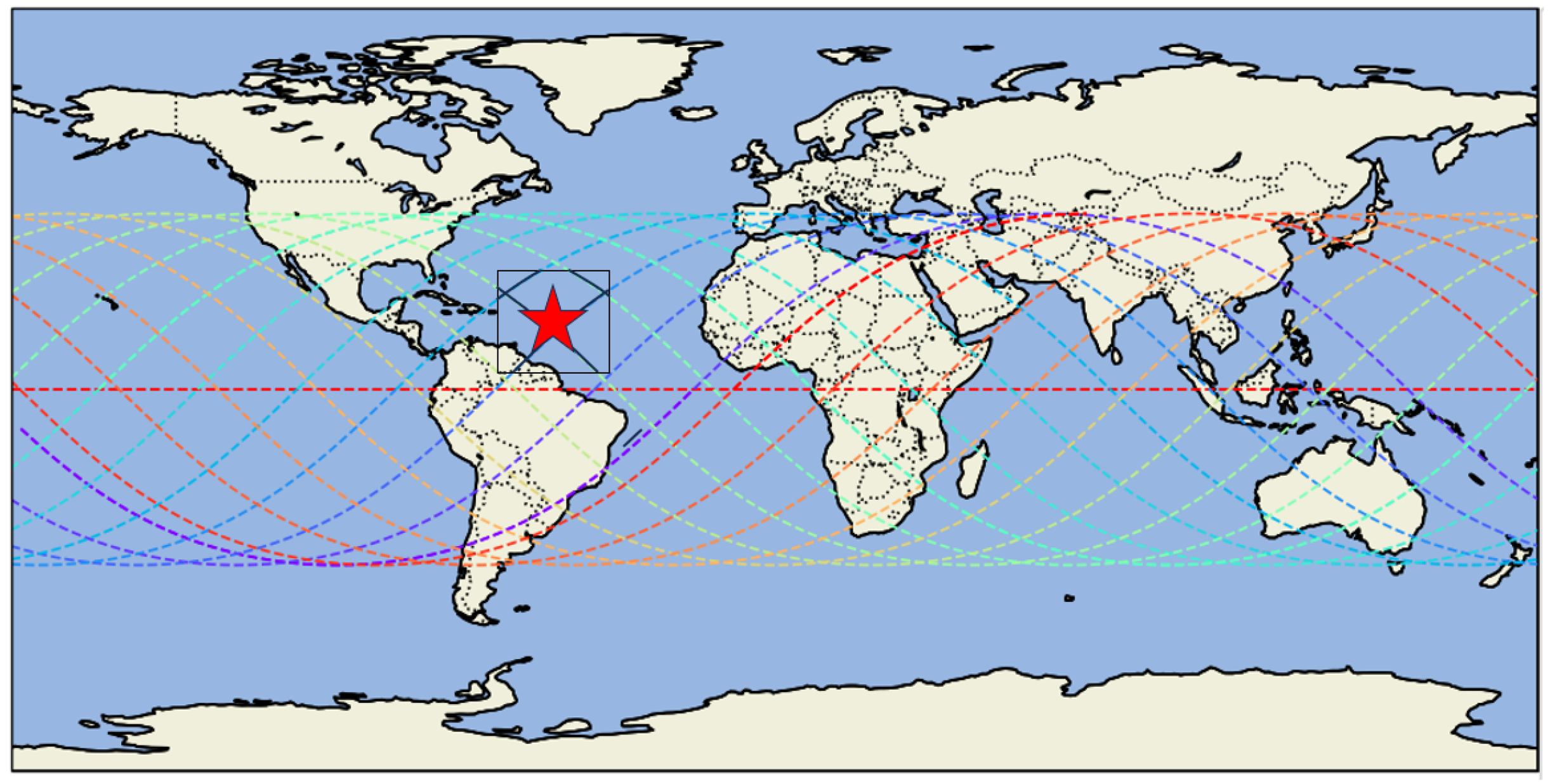
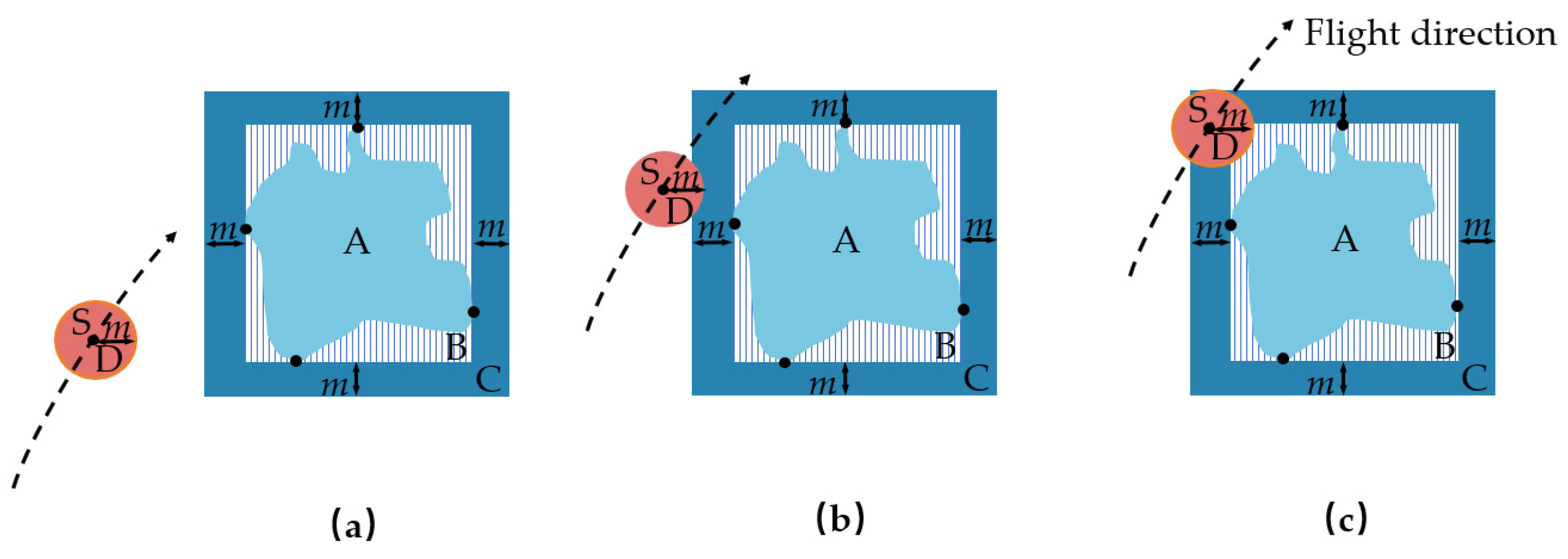
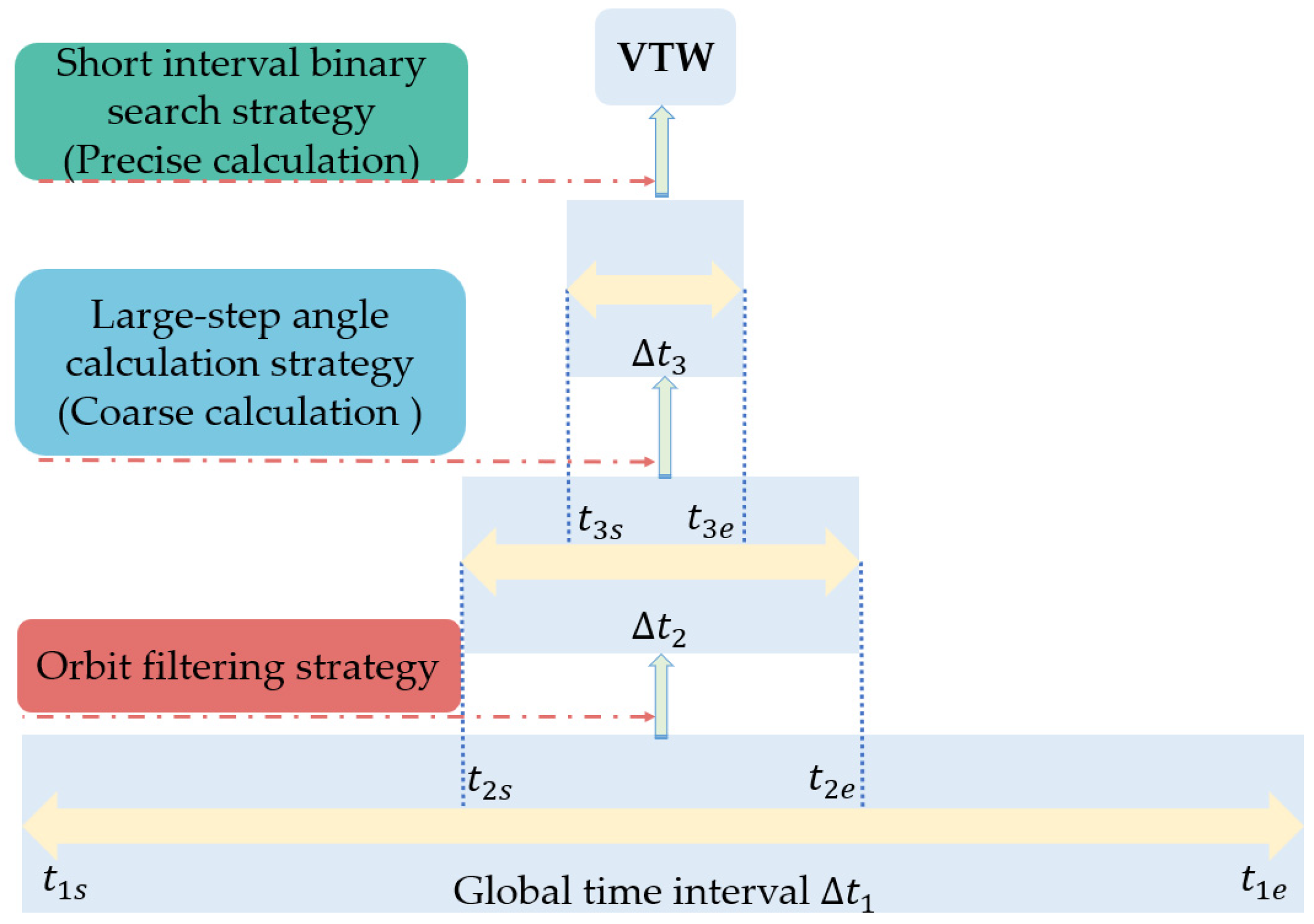

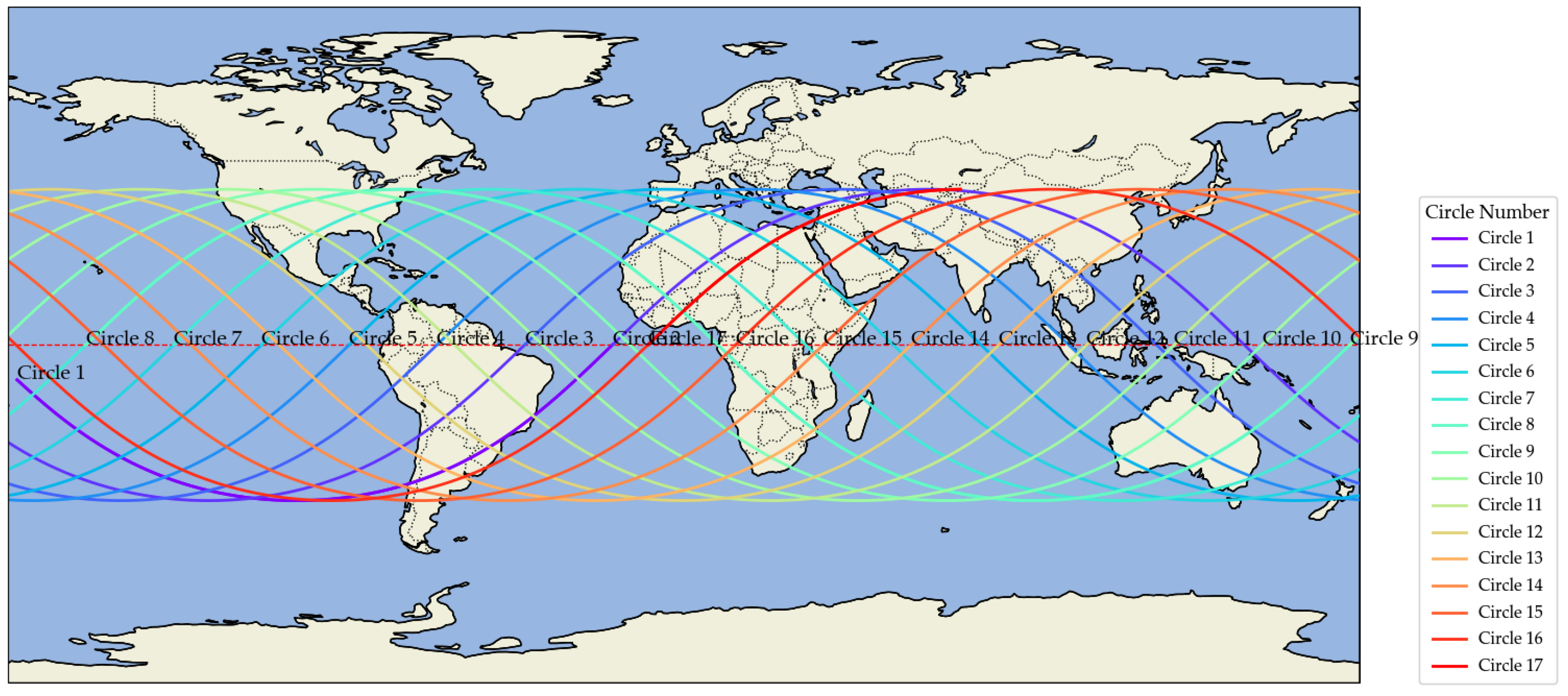

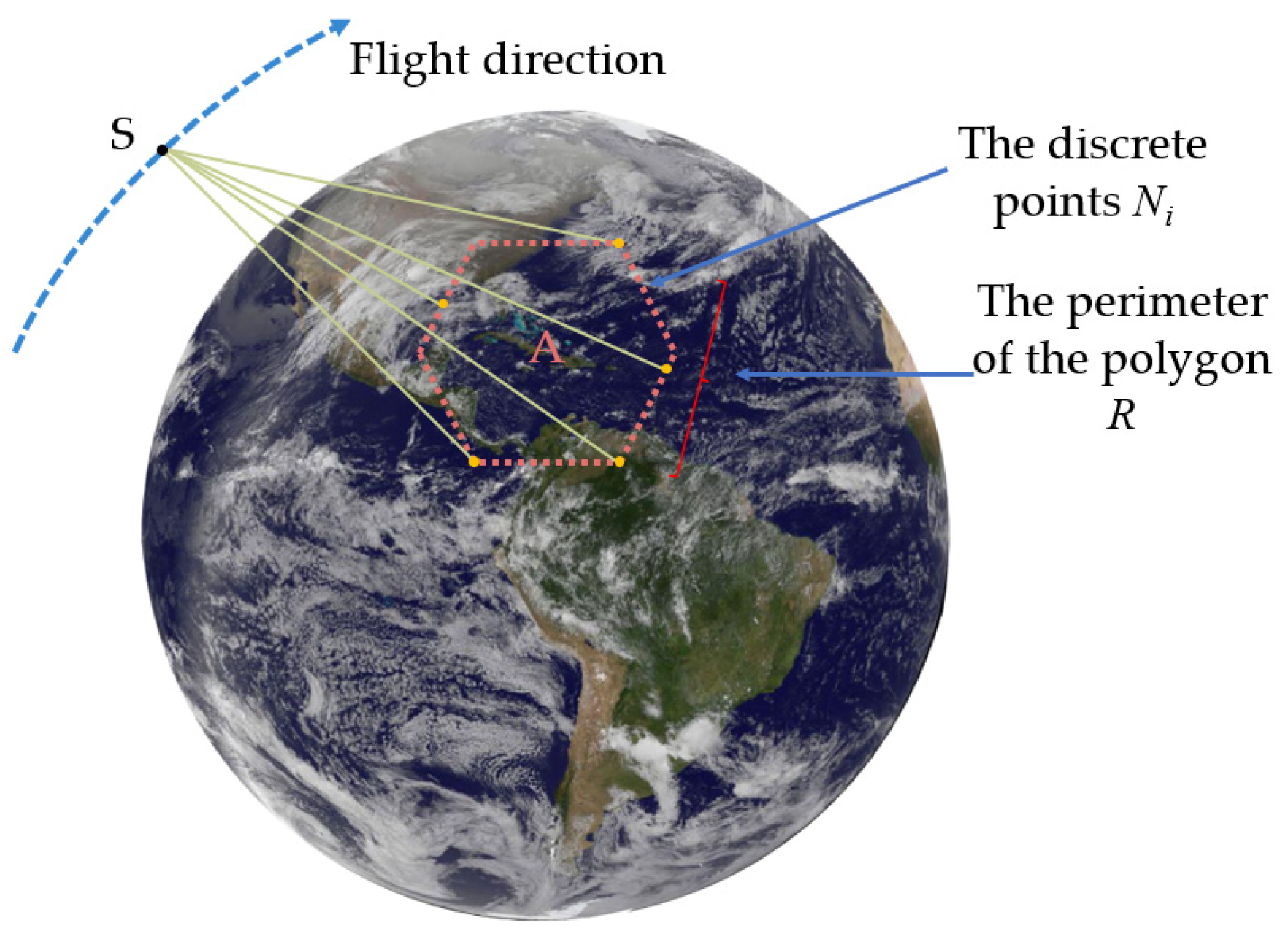
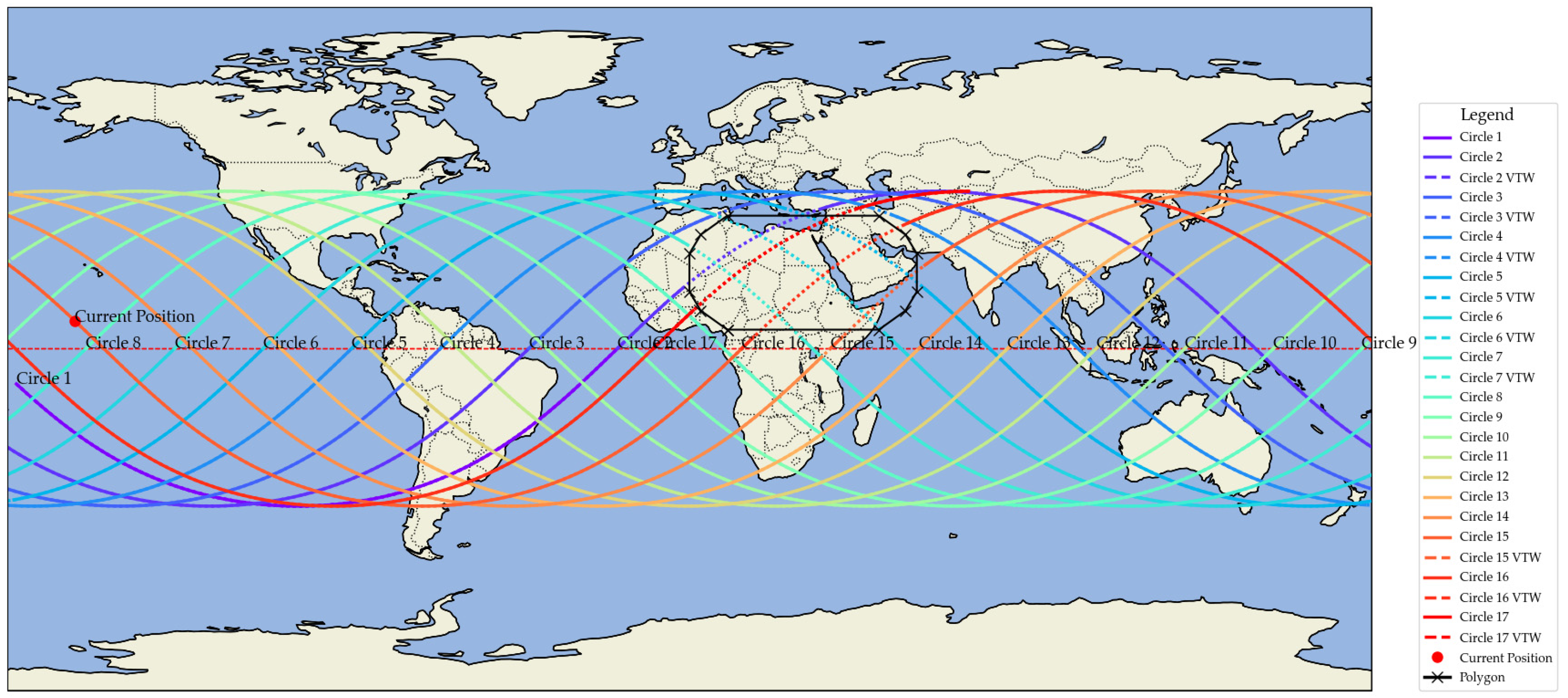

| Category | Parameter |
|---|---|
| Payload | CSS Earth observation payload |
| TLE [40] | 48274U 21035A 23357.28655182 .00041146 00000 + 0 42316-3 0 9997 |
| 48274 41.4711 83.9203 0005576 41.6976 318.4288 15.64081887151409 | |
| Simulation time | 23 December 2023 00:00:00–23 December 2023 24:00:00 (UTC) |
| Time step | ta = 1 s, tb = 90 s, td = 90 s |
| Half field of view angle | 30° |
| Region coordinates | (5° N, 10° E), (5° N, 50° E), (10° N, 57° E), (15° N, 60°E), (25° N, 60° E), (30° N, 57° E), (35° N, 50° E), (35° N, 10° E), (30° N, 3° E), (25° N, 0° E), (15° N, 0° E), (10° N, 3° E) |
| Category | Information |
|---|---|
| Hardware environment | Intel (R) Core (TM) i3-10110U CPU @ 2.10 GHz Processor, 8 GB RAM, 223 GB storage |
| Operating system | Windows 11, X64-based PC |
| Software environment | PyCharm2023.2.5 (Community Edition), Python 3.10, PyEphem |
| Algorithm | Computational Time/s | Computational Time Ratio t% |
|---|---|---|
| TP algorithm T0 | 31.728 | 100% |
| Existing algorithm T1 | 0.317 | 0.999% |
| TTIHS algorithm T2 | 0.116 | 0.365% |
| TP Algorithm | TTIHS Algorithm | |||
|---|---|---|---|---|
| Identification Number | StartEnd Times | Duration/s | Start–End Times | Duration/s |
| 1 (Circle 2) | 00:48:29–00:58:54 | 00:10:25 | 00:48:29–00:58:54 | 00:10:25 |
| 2 (Circle 3) | 02:29:21–02:30:35 | 00:01:14 | 02:29:20–02:30:34 | 00:01:14 |
| 3 (Circle 4) | 04:14:46–04:15:56 | 00:01:10 | 04:14:46–04:15:56 | 00:01:10 |
| 4 (Circle 5) | 05:46:31–05:56:50 | 00:10:19 | 05:46:30–05:56:50 | 00:10:20 |
| 5 (Circle 6) | 07:19:19–07:33:13 | 00:13:54 | 07:19:18–07:33:12 | 00:13:54 |
| 6 (Circle 7) | 08:55:05–09:05:15 | 00:10:10 | 08:55:05–09:05:15 | 00:10:10 |
| 7 (Circle 15) | 20:35:08–20:42:43 | 00:07:35 | 20:35:07–20:42:42 | 00:07:35 |
| 8 (Circle 16) | 22:06:49–22:19:32 | 00:12:43 | 22:06:49–22:19:31 | 00:12:42 |
| 9 (Circle 17) | 23:41:09–23:53:50 | 00:12:41 | 23:41:09–23:53:49 | 00:12:40 |
Disclaimer/Publisher’s Note: The statements, opinions and data contained in all publications are solely those of the individual author(s) and contributor(s) and not of MDPI and/or the editor(s). MDPI and/or the editor(s) disclaim responsibility for any injury to people or property resulting from any ideas, methods, instructions or products referred to in the content. |
© 2024 by the authors. Licensee MDPI, Basel, Switzerland. This article is an open access article distributed under the terms and conditions of the Creative Commons Attribution (CC BY) license (https://creativecommons.org/licenses/by/4.0/).
Share and Cite
Shan, Y.; Du, C.; Li, Y.; Li, Z.; Jin, X.; Zhang, H. Triple Time Interval Hybridization Strategy for Rapidly Calculating Regional Target–Visible Time Window of Earth Observation Payloads on Space Station. Appl. Sci. 2024, 14, 2388. https://doi.org/10.3390/app14062388
Shan Y, Du C, Li Y, Li Z, Jin X, Zhang H. Triple Time Interval Hybridization Strategy for Rapidly Calculating Regional Target–Visible Time Window of Earth Observation Payloads on Space Station. Applied Sciences. 2024; 14(6):2388. https://doi.org/10.3390/app14062388
Chicago/Turabian StyleShan, Yadong, Changshuai Du, Yue Li, Zhipeng Li, Xin Jin, and Hanxun Zhang. 2024. "Triple Time Interval Hybridization Strategy for Rapidly Calculating Regional Target–Visible Time Window of Earth Observation Payloads on Space Station" Applied Sciences 14, no. 6: 2388. https://doi.org/10.3390/app14062388
APA StyleShan, Y., Du, C., Li, Y., Li, Z., Jin, X., & Zhang, H. (2024). Triple Time Interval Hybridization Strategy for Rapidly Calculating Regional Target–Visible Time Window of Earth Observation Payloads on Space Station. Applied Sciences, 14(6), 2388. https://doi.org/10.3390/app14062388






